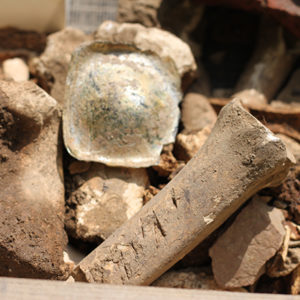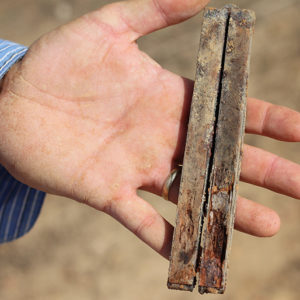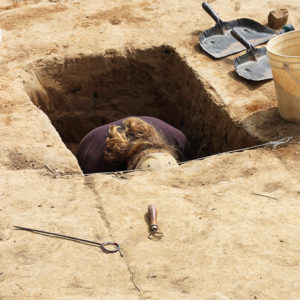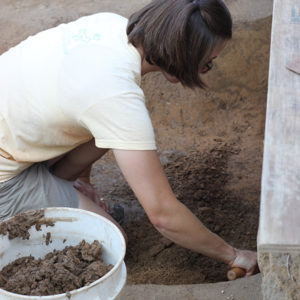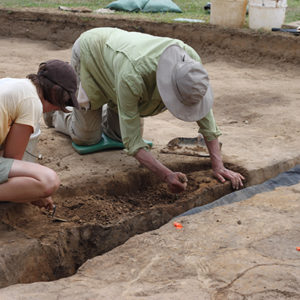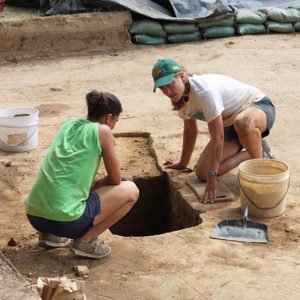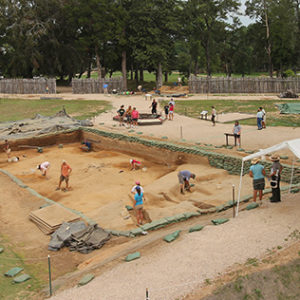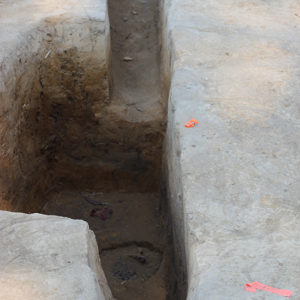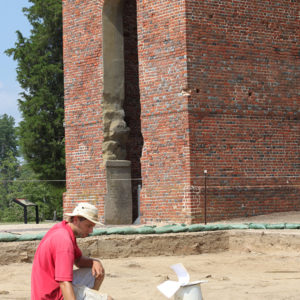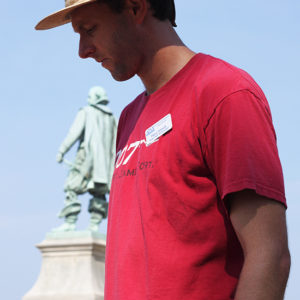The 2010 field school is over, but this year’s students uncovered some very interesting features before heading home. Numerous graves have been found, most of which are in an east/west orientation. Three of the features investigated by the field school students appear to date to after the Civil War and may be evidence of turn-of-the-century archaeological excavations. A boundary ditch dating to the 17th and/or 18th century was found further to the south, dug in a zigzag pattern indicating that it was accompanied by a “Virginia Rail”-style fence. Another ditch, this one backfilled in the 1680s, has yielded several domestic and wild animal bones as well as a handle for a knife made out of bone. Finally, three postholes of very similar depth and diameter have been found which may very well date to the fort period. The holes are surprisingly deep and wide, indicating that the posts supported a substantial structure. The Jamestown Rediscovery archaeological team is performing further excavations to locate more postholes and gain an understanding of the size and shape of the structure.
Many graves are turning up in the current excavation area. This year’s excavations have led to the discovery of over 20 burials, most of which are oriented in an east/west direction. Evidence suggests that many of these graves were dug after the fort period. After they are mapped, the graves will be left undisturbed.
Three grave-shaped features did not match the expected grave orientation, and cut through relatively-modern layers. When excavated, artifacts found within indicated that they were probably test excavations conducted by archaeologists early in the 20th century. The first pit contained brick and mortar fragments matching those of the Jamestown Memorial Church built in 1907. A wood and copper folding ruler was found in this feature. It is thought that this was used by one of the archaeologists during the dig a century ago.
A second hole just to the east appears also to have been an archaeological exploratory pit. Portland cement was found in the fill of the pit, which wasn’t used in Virginia until after the Civil War. This feature may have cut one of the burials as human teeth and bones were found inside. Finally, the westernmost of the three features, the most grave-like of them all, was largely devoid of artifacts, was oriented north to south, and showed no evidence of being used as a burial.
A zigzag ditch, discovered just to the south and possibly a continuation of a ditch found in 2007, probably served as a boundary line and/or livestock barrier and dates to the 17th/18th centuries. The zigzag shape indicates that the ditch was accompanied by a Virginia Rail-style fence, the form of which necessitates a zigzag footprint. The fence/ditch combination may have been used to contain livestock. An example of a Virginia Rail fence can be seen just yards away from the dig site, along the woodline to the north.
A bone handle for a knife was found in a ditch thought to have been backfilled in the 1680s. Bones of domestic animals and deer were found in the ditch, as were dateable weights which helped nail down a timeframe for the feature.
The most interesting finds this month are the series of postholes thought to date to the fort period. The postholes are remarkable in their depth and diameter, indicating they supported a very substantial structure. Three postholes have been found so far, forming what is thought to be one of the ends of the building. If so, the building is 24 feet wide. The first of the postholes forming the length of the building is 12 feet away from the structure’s end. Archaeologists have flagged another spot 12 feet away from the first where they will dig to check for another posthole. Assuming the colonists built the structure with posts at regular intervals, its dimensions might be able to be discerned with those targeted excavations. While excavating any fort-period structure is exciting, this building’s potential for expansive size has created a buzz among the archaeologists. What have they found? August’s excavations are bound to yield more clues.
related images
- A tray of artifacts includes a butchered horse bone
- An excavated folding ruler is evidence of archaeology conducted around the turn of the twentieth century
- Field school student Amadeusz Zajac excavates one of the fort-period postholes
- Field school student Valerie Hall conducts excavations
- Field school students conduct excavations
- Field school students Emily Santoro and Bonnie Roane discuss their feature
- Field school students at work
- One of the postholes found so far
- Senior Archaeologist Danny Schmidt examines one of the possible fort-period postholes
- Senior Archaeologist Danny Schmidt oversees field school students at work



